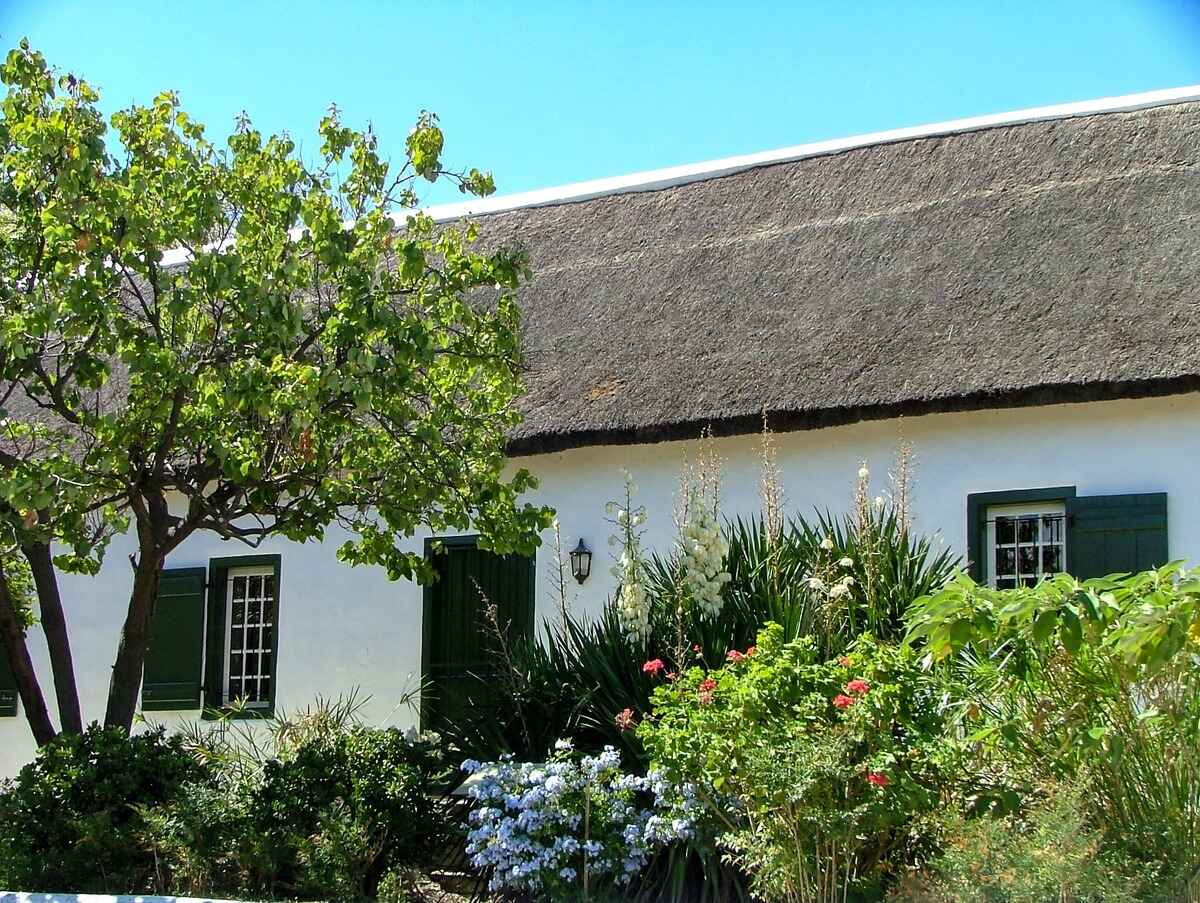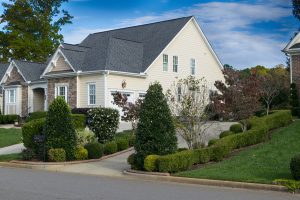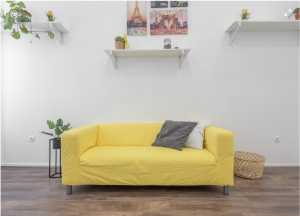Shrubs
Shrubs are an excellent choice for planting in front of your house. They provide structure, privacy, and a touch of greenery to your landscape. Whether you want low-growing shrubs for a neat and tidy appearance or taller shrubs for added privacy, there are plenty of options to choose from. Here are some top choices for shrubs to plant in front of your house:
- Boxwoods: Boxwoods are a classic choice for front yard landscaping. With their dense foliage and compact growth habit, they add a touch of elegance and formality to any home. They can be pruned into neat hedges or left to grow naturally in rounded or square shapes.
- Hydrangeas: Hydrangeas are known for their stunning blooms and long-lasting beauty. They come in a variety of colors, including white, pink, and blue, and can add a whimsical and romantic feel to your front yard. Hydrangeas prefer partial shade and moist, well-drained soil.
- Rose bushes: If you love roses, why not plant some rose bushes in front of your house? Climbing roses can be trained to grow on trellises or fences, while bush roses can add a burst of color and fragrance to your landscape. Just make sure to provide them with enough sunlight and regular pruning.
- Lilacs: Lilacs are prized for their heavenly fragrance and beautiful flowers. They bloom in the spring and come in various shades of purple, pink, and white. Lilacs prefer full sun and well-drained soil, making them a great addition to your front yard.
- Junipers: Junipers are a popular choice for their evergreen foliage and low maintenance requirements. They come in a variety of shapes and sizes, including upright, spreading, and creeping varieties. Junipers are drought-tolerant and can withstand a wide range of soil conditions.
When selecting shrubs for your front yard, consider the mature size of the plants, the amount of sunlight they require, and how well they will complement your house’s architectural style. With the right shrubs in place, you can create a stunning and inviting entrance to your home.
Flowers
Adding a splash of color with flowers is a wonderful way to enhance the curb appeal of your house. Whether you prefer vibrant blooms or delicate petals, there is a wide variety of flowers to choose from. Here are some top choices for flowers to plant in front of your house:
- Petunias: Petunias are known for their striking colors and ability to cascade gracefully from hanging baskets or planters. They are easy to grow, low-maintenance, and can withstand heat and sun.
- Marigolds: Marigolds are a popular choice for their bright orange and yellow blooms. They not only add a cheerful touch to your front yard but also repel pests with their strong scent. Marigolds thrive in full sun and well-drained soil.
- Pansies: Pansies are cool-season flowers that come in a wide range of colors, making them perfect for adding a pop of color to your front yard. They can tolerate light shade and are ideal for planting in early spring or fall.
- Geraniums: Geraniums are versatile flowers that come in different colors and varieties. They are easy to care for and can withstand dry conditions, making them an excellent choice for areas with less rainfall.
- Daisies: Daisies are charming, dainty flowers that add a touch of innocence and simplicity to your front yard. They are low-maintenance and can thrive in a variety of soil types.
When planting flowers in front of your house, consider the color palette that complements your home’s exterior. You can create a cohesive look by choosing flowers that harmonize with the color of your house or contrasting colors for a bold statement. Additionally, pay attention to the blooming season of the flowers, ensuring that you have blooms throughout the year.
Remember to provide the right growing conditions for your flowers, including adequate sunlight, water, and well-drained soil. With a well-designed flower bed in front of your house, you can create a beautiful and inviting atmosphere that will make your home more welcoming.
Evergreens
Evergreen plants are a fantastic choice for adding year-round beauty and structure to the front of your house. These plants retain their foliage throughout the year, providing greenery even during the winter months. Here are some top choices for evergreens to plant in front of your house:
- Boxwoods: Boxwoods are versatile evergreens that can be shaped into formal hedges or left to grow naturally. They have dense foliage and a compact growth habit, making them ideal for creating borders or defining spaces.
- Arborvitae: Arborvitae is a popular evergreen choice due to its tall and slender form. It provides excellent privacy screening and can be planted in rows to create a natural barrier.
- Yews: Yews are slow-growing evergreens with dark green foliage that creates a dramatic and elegant look. They can be pruned into various shapes, such as cones or spirals, to add visual interest to your front yard.
- Hollies: Hollies are known for their glossy evergreen leaves and vibrant berries. They come in many varieties, including dwarf options, and can be used as hedges or standalone focal points.
- Junipers: Junipers are tough and adaptable evergreens that come in various shapes and sizes. They have needle-like foliage and can withstand a range of soil conditions, making them a versatile choice for front yard landscaping.
When incorporating evergreens into your front yard, consider their mature size and how they will complement the overall design of your house. Taller evergreens can provide privacy and act as a backdrop for other plants, while low-growing varieties can add texture and interest to your landscape.
Evergreens require proper maintenance, including regular pruning and watering, to keep them looking their best. By selecting the right evergreens for your front yard and giving them the care they need, you can create a visually appealing and long-lasting green space in front of your house.
Vines
Vines are a fantastic way to add vertical interest and a touch of charm to the front of your house. They can climb up walls, trellises, or arbors, providing a lush and vibrant backdrop to your home. Here are some top choices for vines to plant in front of your house:
- Clematis: Clematis is a popular vine known for its beautiful, showy flowers in various colors. They come in different varieties, some with large blooms and others with delicate, bell-shaped flowers. Clematis thrives in full sun or partial shade and prefers well-drained soil.
- Wisteria: Wisteria is a stunning vine that produces cascades of fragrant and colorful flowers in the spring. It adds elegance and a romantic touch to any front yard. However, wisteria requires sturdy support and regular pruning to maintain its shape and prevent it from overwhelming the space.
- Honeysuckle: Honeysuckle is a sweet-scented vine that attracts hummingbirds and butterflies with its tubular flowers. It can be planted near entrances or windows to enjoy its fragrance. Honeysuckle thrives in well-drained soil and partial shade.
- Trumpet Vine: Trumpet vine is a vigorous vine that produces vibrant orange-red flowers in the summer. It attracts hummingbirds and butterflies and can be grown on trellises or arbors for a dramatic effect. Trumpet vine prefers full sun and can tolerate a wide range of soil conditions.
- Passionflower: Passionflower is a unique vine with exotic flowers that resemble the shape of a passion fruit. It adds a tropical flair to your front yard and attracts butterflies. Passionflower thrives in full sun and well-drained soil.
When choosing vines for your front yard, consider the support structure needed for each type of vine. Some vines, like clematis and honeysuckle, require trellises or fences, while others, like wisteria and trumpet vine, need sturdy arbors or pergolas.
It’s important to note that some vines can be aggressive and require regular pruning to prevent them from taking over your space. Be sure to research the specific needs and growth habits of the vine you choose, and provide proper maintenance accordingly.
With the right choice of vines and proper care, you can create a captivating and inviting facade for your house, adding a touch of natural beauty to your front yard.
Ornamental Grasses
Ornamental grasses are a fantastic addition to the front of your house, providing texture, movement, and a unique aesthetic appeal. They come in various sizes, colors, and shapes, allowing you to create different visual effects in your landscape. Here are some top choices for ornamental grasses to plant in front of your house:
- Fountain Grass: Fountain grass is a popular ornamental grass with its graceful arching blades and fluffy, plume-like flowers. It adds a soft and elegant touch to any front yard, and there are different varieties to choose from, including purple, red, and green.
- Maiden Grass: Maiden grass is a tall, upright grass with slender leaves and feathery flower spikes. It creates a dramatic effect with its height and movement, making it an excellent focal point in your front yard. Maiden grass comes in various cultivars with different foliage colors and sizes.
- Japanese Silver Grass: Japanese silver grass, or miscanthus, is a beautiful ornamental grass known for its tall, elegant plumes and cascading foliage. It adds a touch of sophistication and drama to your front yard. Japanese silver grass comes in different varieties, including ones with variegated leaves.
- Ribbon Grass: Ribbon grass, or reed grass, features long, arching leaves with cream or white stripes. It has a spreading growth habit and can be used to create groundcover or as an accent plant in your front yard. Ribbon grass is low-maintenance and tolerates a variety of soil conditions.
- Zebra Grass: Zebra grass is known for its distinct horizontal stripes that resemble a zebra’s pattern. It adds architectural interest to your front yard and pairs well with other grasses and plants. Zebra grass is hardy and low-maintenance.
When incorporating ornamental grasses into your front yard, consider their mature size and how they will complement the overall design of your house. Taller ornamental grasses can create a stunning backdrop or screen, while shorter varieties can be used as borders or accents.
Ornamental grasses are typically low-maintenance and require minimal pruning. They can thrive in a variety of soil conditions and are often drought-tolerant once established. Their unique textures and movement add visual interest to your landscape and make your front yard a captivating space.
Groundcover Plants
Groundcover plants are an excellent choice for filling in gaps, suppressing weeds, and adding a lush carpet-like look to the front of your house. They provide a neat and tidy appearance while reducing the amount of maintenance required for your landscape. Here are some top choices for groundcover plants to plant in front of your house:
- Creeping Thyme: Creeping thyme is a low-growing, spreading groundcover that releases a delightful fragrance when crushed. It features small, aromatic leaves and clusters of pink, purple, or white flowers. Creeping thyme is drought-tolerant and can withstand foot traffic, making it perfect for walkways or between stepping stones.
- Creeping Jenny: Creeping Jenny, or moneywort, is a fast-spreading groundcover with bright yellow-green leaves that create a vibrant carpet-like effect. It thrives in moist soil and can tolerate partial shade, making it an ideal choice for areas with less sunlight.
- Creeping Phlox: Creeping phlox is a beautiful groundcover that produces masses of colorful flowers in the spring. It comes in various shades, including pink, purple, white, and blue. Creeping phlox prefers well-drained soil and full sun to bloom its best.
- Creeping Sedum: Creeping sedum, also known as stonecrop, is a hardy and low-maintenance groundcover that thrives in dry and rocky soil. It features fleshy, succulent leaves that store water, making it drought-tolerant. Creeping sedum has clusters of colorful flowers that attract pollinators.
- Irish Moss: Irish moss is a dense and compact groundcover with tiny, emerald-green leaves that resemble moss. It forms a plush carpet-like mat and produces small, star-shaped white flowers in the spring. Irish moss prefers moist soil and partial shade.
When choosing groundcover plants for your front yard, consider their growth habit and how they will complement the overall design of your house. Some groundcovers spread quickly, providing more coverage and minimizing the need for frequent planting. Others may have specific soil or light requirements, so it’s important to choose the right plant for your specific conditions.
Groundcover plants generally require less maintenance than other types of plants. However, regular watering, occasional pruning, and weed control may still be necessary to keep them looking their best. With the right groundcover plants in place, you can achieve a uniform and visually appealing front yard that is both attractive and low-maintenance.
Climbing Roses
Climbing roses are a beautiful and elegant addition to the front of your house, adding a touch of romance and splendor to your landscape. These roses have long canes that can be trained to grow vertically on walls, trellises, or fences, creating a stunning display of colorful blooms. Here are some top choices for climbing roses to plant in front of your house:
- New Dawn: New Dawn is a popular climbing rose known for its fragrant pale pink flowers. This vigorous and disease-resistant rose blooms repeatedly throughout the season, creating a cascade of blooms.
- Climbing Iceberg: Climbing Iceberg is a classic choice with its pure white blooms that have a slightly sweet fragrance. This rose is highly disease-resistant and produces a profusion of flowers from spring to fall.
- Blaze Climbing Rose: Blaze climbing rose is a vigorous and hardy variety with deep red, double blooms. It provides a striking contrast against green foliage and can create a dramatic focal point in your front yard.
- Sally Holmes: Sally Holmes is an elegant climbing rose with creamy white blooms that age to a soft pink hue. This rose is disease-resistant and blooms prolifically, making it a charming choice for any front yard.
- Joseph’s Coat: Joseph’s Coat is a climbing rose with stunning multi-colored blooms that transition from yellow to orange to red. The vibrant colors add a bold and eye-catching feature to your front yard, creating a vibrant display.
When planting climbing roses in front of your house, choose a location that provides full sun for at least six hours a day. Roses also require well-draining soil with organic matter. Provide adequate support, such as a trellis or an arbor, to allow the roses to climb and grow properly.
It’s important to note that climbing roses require regular pruning and training to maintain their shape and encourage healthy growth. Prune in early spring or late winter to remove dead or damaged wood and to shape the plant. Regularly tie the canes to the support structure to guide them in the desired direction.
With their beauty and fragrance, climbing roses will make a stunning statement in the front of your house, creating a charming and inviting atmosphere for your home.
Perennials
Perennial plants are a fantastic choice for adding long-lasting beauty and color to the front of your house. Unlike annuals that need to be replanted every year, perennials come back year after year, providing reliable blooms that return with the changing seasons. They come in a wide variety of shapes, sizes, and colors, allowing you to create a diverse and visually appealing front yard. Here are some top choices for perennials to plant in front of your house:
- Lavender: Lavender is a fragrant perennial herb known for its beautiful purple flowers and aromatic foliage. It adds a touch of elegance and a soothing scent to your front yard. Lavender thrives in full sun and well-drained soil.
- Black-Eyed Susan: Black-Eyed Susan is a popular perennial with bright yellow or orange petals and a dark central cone. It blooms from late summer to fall and attracts butterflies and bees. Black-Eyed Susan prefers full sun and well-drained soil.
- Daylilies: Daylilies are low-maintenance perennials that come in a wide range of colors, including orange, yellow, pink, and purple. They have trumpet-shaped flowers that bloom for a single day, but each plant produces numerous buds. Daylilies are adaptable and can thrive in various soil conditions.
- Hostas: Hostas are shade-loving perennials that are prized for their attractive foliage. They come in different shades of green and have various leaf shapes and sizes. Hostas are ideal for adding texture and visual interest to your front yard.
- Coneflowers: Coneflowers, or Echinaceas, are drought-tolerant perennials with vibrant daisy-like flowers. They come in various colors, including purple, pink, and white, and attract pollinators to your front yard. Coneflowers prefer full sun and well-drained soil.
When planting perennials in front of your house, consider their height, flowering season, and color to create a harmonious and visually appealing display. Grouping perennials with similar growth habits and complementary colors can create a stunning effect.
It’s important to provide proper care for your perennials, including regular watering, mulching, and fertilizing. Some perennials may require dividing every few years to maintain their vigor and prevent overcrowding.
With their ability to come back year after year, perennials will continue to add beauty and charm to the front of your house, enhancing the overall appeal of your landscape.
Boxwoods
Boxwoods are a classic and versatile choice for planting in front of your house. These evergreen shrubs are known for their dense foliage, compact growth habit, and ability to be easily shaped and pruned. They add a touch of elegance, structure, and formality to any front yard. Here are some key aspects of boxwoods to consider:
- Variety: Boxwoods come in various cultivars, offering a range of sizes and shapes to suit different preferences and landscaping needs. Some popular varieties include the American boxwood (Buxus sempervirens), the English boxwood (Buxus sempervirens ‘Suffruticosa’), and the Korean boxwood (Buxus microphylla var. microphylla).
- Formal Hedges: Boxwoods are often used to create neat and well-defined formal hedges due to their tight growth habit and ability to tolerate shearing. They can be trained into various shapes, such as rectangles, squares, or even intricate topiaries, adding a polished and tailored look to your front yard.
- Landscaping Accents: Boxwoods also work well as individual specimens or as focal points in your front yard. Their evergreen foliage provides year-round interest, and their versatility allows them to be incorporated into various landscape designs. You can use them to frame entryways, flank pathways, or create boundary plantings.
- Care and Maintenance: Boxwoods are relatively low-maintenance shrubs but still require some care to thrive. They prefer well-draining soil and partial shade to full sun. Regular watering and mulching are essential, especially during dry periods. Pruning is necessary to maintain the desired shape and density of the plants.
- Environmental Suitability: Boxwoods are typically well-adapted to many regions, but it’s important to consider your local climate and growing conditions when selecting boxwood varieties. Some cultivars are more cold-hardy, while others thrive in warmer climates. Consulting with a local gardening expert can help you choose the most suitable boxwoods for your specific area.
When incorporating boxwoods into your front yard, consider their mature size and the desired function they will serve in your landscape. Plan their placement accordingly to ensure they have enough space to grow without overcrowding or obstructing pathways and views.
With their versatile nature and ability to add structure and elegance to any front yard, boxwoods are a timeless choice for homeowners seeking a polished and refined landscape.
Hydrangeas
Hydrangeas are beloved flowering shrubs that add charm, beauty, and a touch of nostalgia to the front of your house. Known for their large, showy blooms and lush foliage, hydrangeas can create a stunning focal point in your landscape. Here are some key aspects of hydrangeas to consider:
- Variety: Hydrangeas come in a variety of species and cultivars, each with its unique characteristics. Some popular varieties include the mophead hydrangea (Hydrangea macrophylla) with its large globular clusters of flowers, the lacecap hydrangea (Hydrangea macrophylla normalis) with its delicate, flat-topped flowers, and the panicle hydrangea (Hydrangea paniculata) with its elongated cone-shaped flowers.
- Blooms: One of the standout features of hydrangeas is their luscious blooms, which can range in color from shades of white, pink, blue, and purple, depending on the soil pH and the variety of the hydrangea. Adjusting the soil pH can allow you to influence the color of the blooms, with acidic soil producing blue flowers and alkaline soil producing pink flowers.
- Growth and Care: Hydrangeas generally prefer partial shade and well-draining soil that retains moisture. Proper watering and mulching are important to keep them healthy and hydrated. Pruning is necessary, especially for certain varieties, to maintain their shape, promote flowering, and remove any dead wood. Understanding the specific pruning requirements of the hydrangea variety you choose is essential.
- Landscaping Uses: Hydrangeas can be used in various ways in your front yard. They make stunning specimen plants, attracting attention with their beautiful blooms. Hydrangeas can also be used as foundation plantings or in borders to create a soft and romantic feel. They are versatile and can be incorporated into different landscape styles, from traditional to cottage garden designs.
- Seasonal Interest: While hydrangeas are mainly appreciated for their gorgeous blooms, many varieties offer additional interest during other seasons. Some hydrangeas have attractive foliage that changes color in the fall, and some even have interesting bark or peeling bark that adds winter interest to your front yard.
When incorporating hydrangeas into your front yard, consider their mature size, growth habit, and the specific lighting and soil conditions they require. This will help ensure their optimal growth and longevity in your landscape.
With their stunning blooms, range of colors, and versatile nature, hydrangeas can transform the front of your house into an enchanting and captivating space.





